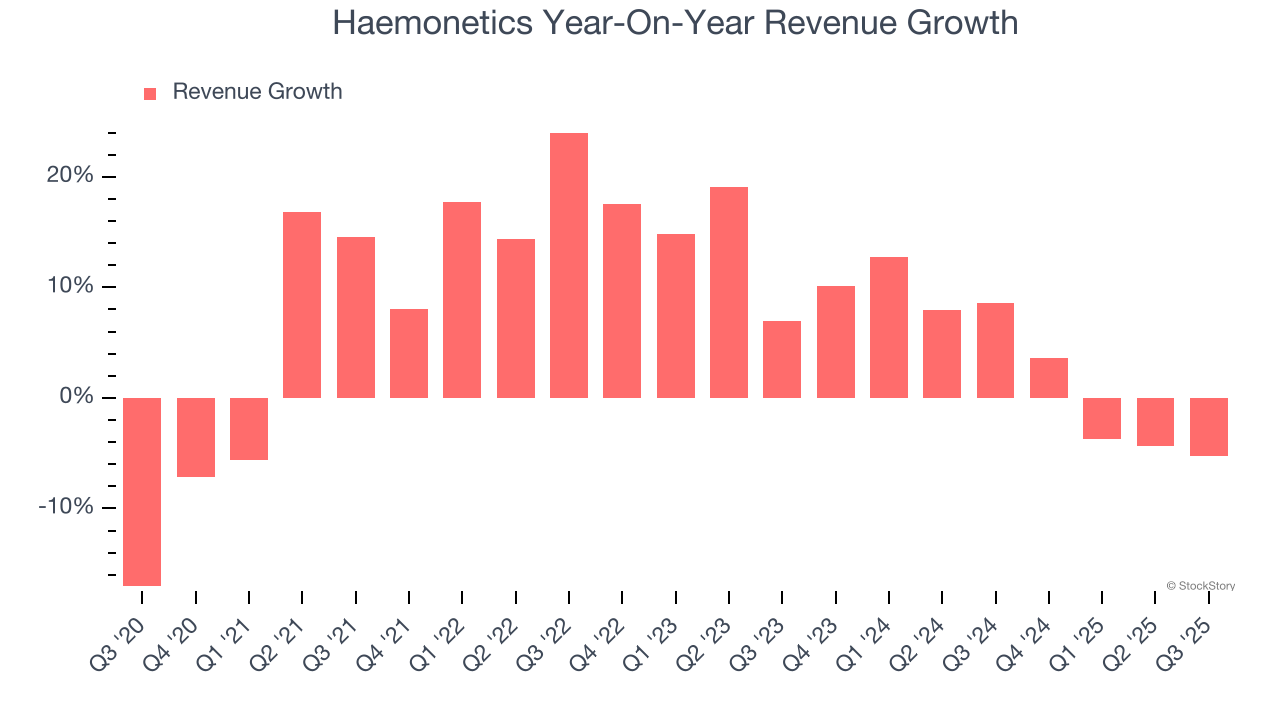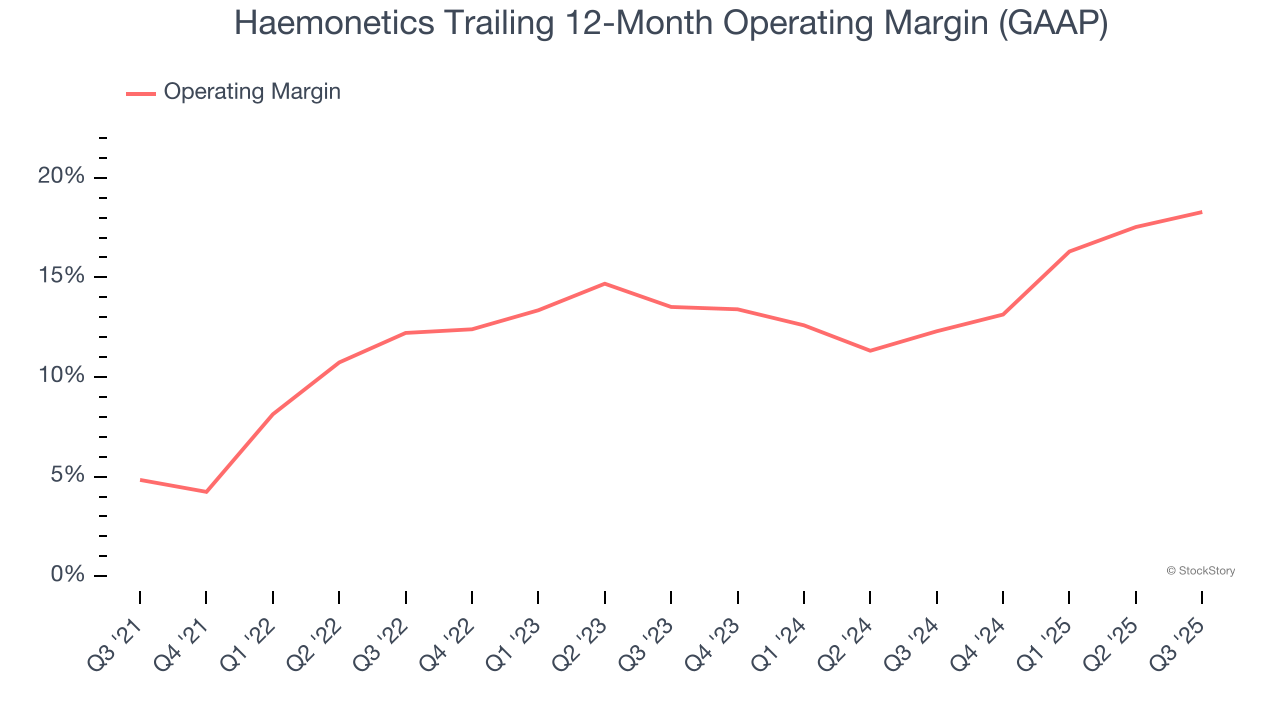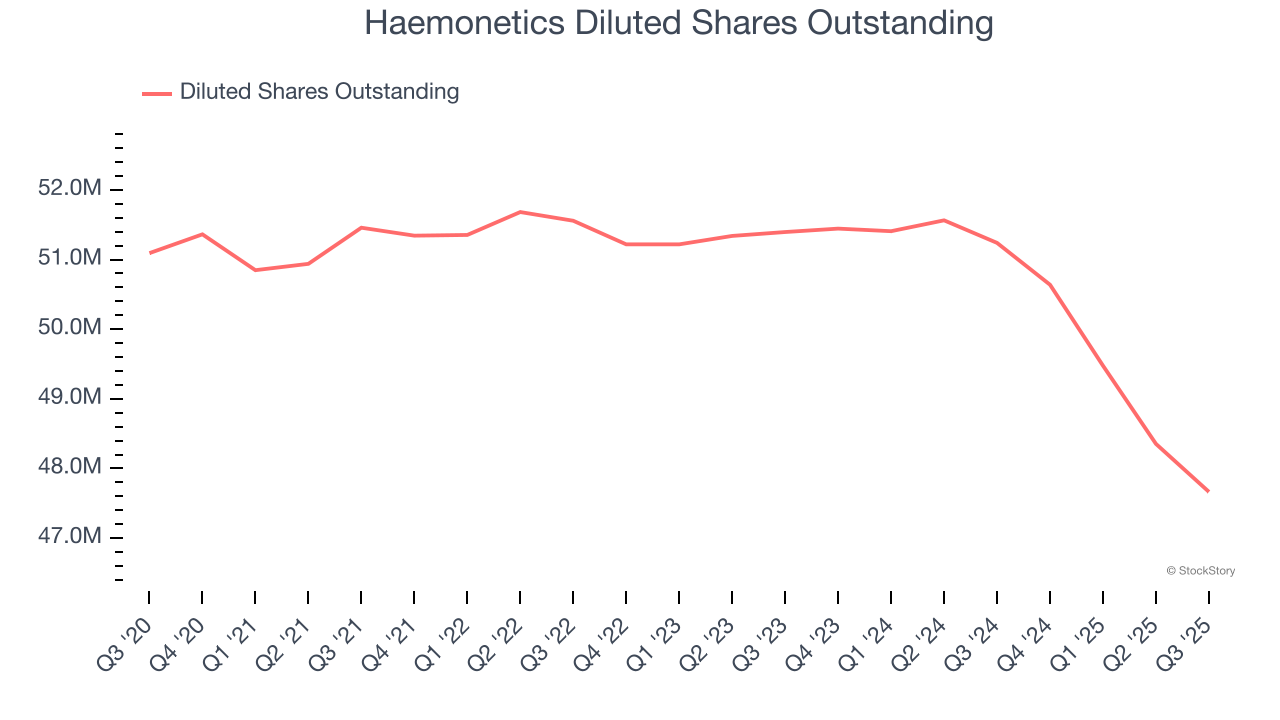
Blood products company Haemonetics (NYSE:HAE). reported revenue ahead of Wall Streets expectations in Q3 CY2025, but sales fell by 5.3% year on year to $327.3 million. Its non-GAAP profit of $1.27 per share was 14.3% above analysts’ consensus estimates.
Is now the time to buy Haemonetics? Find out by accessing our full research report, it’s free for active Edge members.
Haemonetics (HAE) Q3 CY2025 Highlights:
- Revenue: $327.3 million vs analyst estimates of $310.8 million (5.3% year-on-year decline, 5.3% beat)
- Adjusted EPS: $1.27 vs analyst estimates of $1.11 (14.3% beat)
- Adjusted EBITDA: $94.34 million vs analyst estimates of $98.45 million (28.8% margin, 4.2% miss)
- Management raised its full-year Adjusted EPS guidance to $4.90 at the midpoint, a 1% increase
- Operating Margin: 17.9%, up from 15% in the same quarter last year
- Free Cash Flow Margin: 32.5%, up from 11.4% in the same quarter last year
- Organic Revenue fell 1.8% year on year vs analyst estimates of 5.3% declines (354.4 basis point beat)
- Market Capitalization: $2.44 billion
Company Overview
With roots dating back to 1971 and a mission to improve blood-related healthcare, Haemonetics (NYSE:HAE) provides specialized medical devices and software for blood collection, processing, and management across plasma centers, blood banks, and hospitals.
Revenue Growth
A company’s long-term performance is an indicator of its overall quality. Even a bad business can shine for one or two quarters, but a top-tier one grows for years. Thankfully, Haemonetics’s 8% annualized revenue growth over the last five years was decent. Its growth was slightly above the average healthcare company and shows its offerings resonate with customers.

Long-term growth is the most important, but within healthcare, a half-decade historical view may miss new innovations or demand cycles. Haemonetics’s recent performance shows its demand has slowed as its annualized revenue growth of 3.5% over the last two years was below its five-year trend. 
Haemonetics also reports organic revenue, which strips out one-time events like acquisitions and currency fluctuations that don’t accurately reflect its fundamentals. Over the last two years, Haemonetics’s organic revenue averaged 3.1% year-on-year growth. Because this number aligns with its two-year revenue growth, we can see the company’s core operations (not acquisitions and divestitures) drove most of its results. 
This quarter, Haemonetics’s revenue fell by 5.3% year on year to $327.3 million but beat Wall Street’s estimates by 5.3%.
Looking ahead, sell-side analysts expect revenue to remain flat over the next 12 months, a deceleration versus the last two years. This projection doesn't excite us and suggests its products and services will see some demand headwinds.
Software is eating the world and there is virtually no industry left that has been untouched by it. That drives increasing demand for tools helping software developers do their jobs, whether it be monitoring critical cloud infrastructure, integrating audio and video functionality, or ensuring smooth content streaming. Click here to access a free report on our 3 favorite stocks to play this generational megatrend.
Operating Margin
Haemonetics has done a decent job managing its cost base over the last five years. The company has produced an average operating margin of 12.7%, higher than the broader healthcare sector.
Analyzing the trend in its profitability, Haemonetics’s operating margin rose by 13.4 percentage points over the last five years, as its sales growth gave it operating leverage. Zooming in on its more recent performance, we can see the company’s trajectory is intact as its margin has also increased by 4.8 percentage points on a two-year basis.

This quarter, Haemonetics generated an operating margin profit margin of 17.9%, up 2.9 percentage points year on year. This increase was a welcome development, especially since its revenue fell, showing it was more efficient because it scaled down its expenses.
Earnings Per Share
Revenue trends explain a company’s historical growth, but the long-term change in earnings per share (EPS) points to the profitability of that growth – for example, a company could inflate its sales through excessive spending on advertising and promotions.
Haemonetics’s EPS grew at a spectacular 12.1% compounded annual growth rate over the last five years, higher than its 8% annualized revenue growth. This tells us the company became more profitable on a per-share basis as it expanded.

We can take a deeper look into Haemonetics’s earnings quality to better understand the drivers of its performance. As we mentioned earlier, Haemonetics’s operating margin expanded by 13.4 percentage points over the last five years. On top of that, its share count shrank by 6.7%. These are positive signs for shareholders because improving profitability and share buybacks turbocharge EPS growth relative to revenue growth. 
In Q3, Haemonetics reported adjusted EPS of $1.27, up from $1.12 in the same quarter last year. This print easily cleared analysts’ estimates, and shareholders should be content with the results. Over the next 12 months, Wall Street expects Haemonetics’s full-year EPS of $4.80 to grow 7.5%.
Key Takeaways from Haemonetics’s Q3 Results
We were impressed by how significantly Haemonetics blew past analysts’ organic revenue expectations this quarter. We were also excited its revenue outperformed Wall Street’s estimates by a wide margin. Zooming out, we think this was a good print with some key areas of upside. The stock traded up 12.8% to $57.23 immediately following the results.
Haemonetics may have had a good quarter, but does that mean you should invest right now? What happened in the latest quarter matters, but not as much as longer-term business quality and valuation, when deciding whether to invest in this stock. We cover that in our actionable full research report which you can read here, it’s free for active Edge members.
